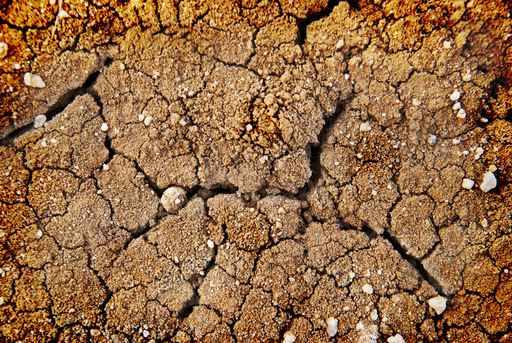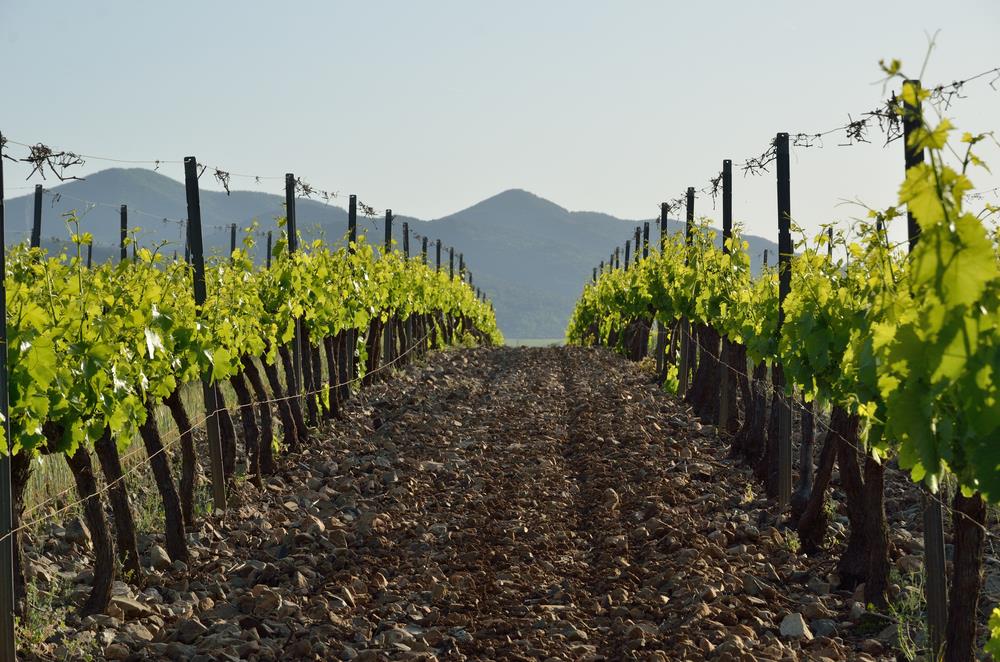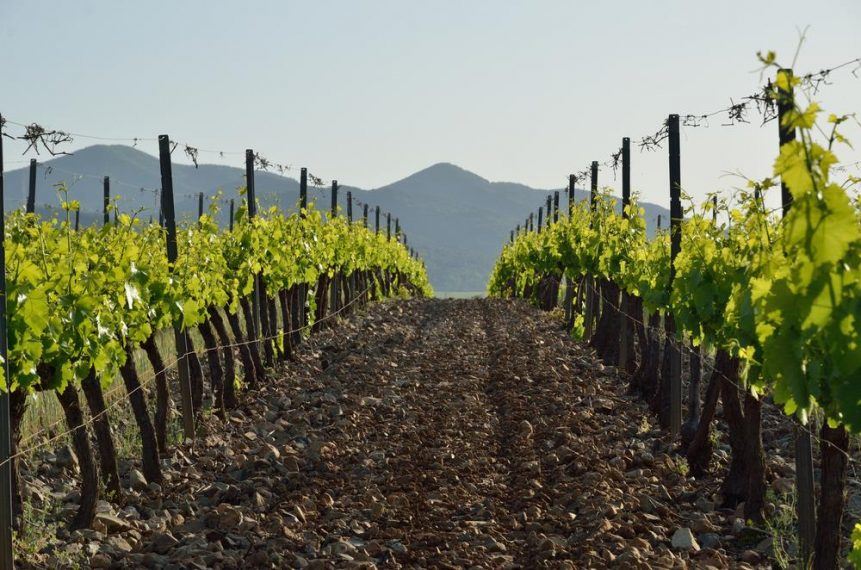When I first got the garden 10 years ago, I dug around to get weeds out. Since then, I've added compost and other organics to the surface, as well as mulch. As far as I'm concerned, clay soil is great soil and is easiest to work with if you mostly leave it alone.
I've established permanent garden beds and I never walk on the soil in my garden beds. I create an environment where worms can thrive, and I let them do the work of creating good soil structure. I never ruin the soil structure by tilling or needless digging. I also let the plant roots do the work of breaking up the soil. I help it hold moisture in the dry season by covering it with mulch at all times. The mention of clay soil to many gardeners will probably make them shudder.
I had a gardener once tell me that clay was meant for making pottery, not for growing plants! Clay soils are mineral soils with very small particles. These are generally low in organic matter and have very small pore spaces, making it difficult for plant roots to penetrate and gather needed air and water.
That's why too much clay in the soil can be a detriment to plant growth. Plant roots need a balance of air pockets and available water, but in heavy clay soils, air pockets are very small and scarce. You can begin, on a small scale, to improve the soil by working in lots of compost or other organic matter. Choose flower or vegetable beds that you want to plant this year and spread a three or four inch layer of mulch on top. Work it in to a depth of at least six inches, deeper if you can. Continue to do this year after year to help "fluff" up the soil.
If you start small, in beds you plan to use immediately, you can spread your soil improvement efforts throughout the yard over several growing season. Persistence will pay off and eventually you'll have a loamy-type soil that will drain well yet hold important nutrients and moisture. Cover crops, also called green manure crops, help loosen clay or compacted soils with their roots and by adding organic matter.
They also prevent nutrient loss and erosion during the non-growing season. Leguminous cover crops, such as winter rye, alfalfa, hairy vetch and clover, which add nitrogen to the soil, are usually planted at the end of summer or early fall. Be sure and add when your clay soil is dry, as working in wet clay is not only quite messy but will compact it even further.
Peat moss is sometimes recommended as an addition, but this breaks down quickly in wet and clay soils, and can create an undesirable bog. As an aside, glomalin also benefits the soil, and earth in general, by storing carbon. Along with adding compost, a second strategy for adding organic matter to my clay soil is cover cropping. I plant cover crops any time the beds in my garden would otherwise be unplanted or fallow. Fallow periods provide little additional organic biomass while allowing the decomposition of organic matter in the soil to continue.
They contribute to the improvements in soil structure that I described earlier. And they can smother weeds and even suppress weed seed germination. Many cover crops will also suppress pathogenic nematodes, for example root knot nematode. For a home gardener with heavy clay soil creating a garden or planting in the landscape is a task. It is essential to work up and fortify the soil in all beds and planting areas.
Clay soil is easiest to amend when it has a light amount of moisture and is easily dug. Work up the soil with either a tiller or use a spading fork to manually break it up as deep as you can–a depth of 1 to 2 feet is good, depending on what you are planting. As the soil is turned over and loosened, it is gaining air pockets.
Expose the broken up clay to the sun and air for a while, then break it up further. Once the clay is as light as can be, it's time to add lots of organic matter. Adding compost, manure or any sort of mulch from bark shreds to coffee grounds adds humus.
Clay particles clump around the humus so aeration and drainage improve. Keep adding mulch layers as they break down and become incorporated into the soil. Over the years of gardening and landscaping on this property, we continually had to battle the clay soils. Heavy clay soils are the result of too much clay and silt particles and too little humus, organic matter.
The clay particles bind together and form heavy clumps which hold the water, are difficult to work and also difficult for plant roots to penetrate. While working with clay is tough on gardeners, the biggest issue for plants is the slow drainage. Improving its structure improves drainage; planting in raised beds made with good soil also helps. With careful management and generous additions of organic material, clay soil will improve over time — lots of time. The soil will become more workable, but expect to spend a few years amending clay before you notice an appreciable difference. Organic matter in soil serves as food for earthworms, insects, bacteria and fungi-they transform it to soil nutrients and humus.
Through this decomposition process, materials are made available as foods to growing plants. In finely textured clay soils, organic material creates aggregates of the soil particles, improving drainage and making it easier to work. Earthworms are especially helpful in making and keeping soil porous and well draining, said Brewer. Bark, sawdust, manure, leaf mold, compost and peat moss are among the organic amendments commonly used to improve clay soil.
Two or three inches of organic materials should be spread and rototilled, forked or dug into the top six or seven inches of your garden beds. During the initial, pre-garden phase of my soil improvement plan, I managed to break up 10 inches of hard-packed clay with endless swings of my trusty mattock. I spread compost over the surface of the beds an inch at a time and rototilled it in. I was careful not to work the clay when it was too wet, because clay worked wet can result in some tenacious clods, very reluctant in their willingness to ever come apart again.
I tried to work the compost deep into the soil, and along with it, I added lime and phosphorus, the clay soil in my garden needing both. When surface-applied, neither of these materials moves down through the soil, so incorporation to ample depth is very important to permit roots to grow into the subsoil. After 3 to 4 inches of compost, I had the "raised bed" I wanted.
The addition of large amounts of organic matter will transform clay soil. Both Black Gold Peat Moss and Black Gold Garden Compost Blend will do wonders. Add these products to your gardens at a ratio of one part organic matter to two parts soil for lasting fertility. Be sure that they are well incorporated to help maintain air pockets and soil loft. These products will 'open' heavy clay soils, improve drainage, and allow water to move more freely. Once everything is incorporated, apply fertilizer as needed, and get planting.
Amend clay soil by adding plenty of organic material, such as well-aged compost, sawdust (but not from pressure-treated wood), composted manure or leaf mould . For example, when making a new bed, spread several inches of organic material over the area and dig it in at least eight inches deep. When moving or adding new perennials to an existing bed, throw a shovelful of compost into the planting hole. To improve your soil, you'll need to add 6 to 8 inches of organic matter to the entire bed. Grass clippings (as long as they haven't been treated with chemicals), shredded leaves, rotted manure, and compost are all perfect choices. The organic matter needs to be mixed into the top 6 to 12 inches of soil.
Digging it in and mixing it with a shovel is a great way to do this, as it moves a lot of earth without pulverizing the soil particles the way tilling can. However, if digging is just too hard on your back, using a tiller is a fine method. Some people claim you can loosen clay by adding gypsum to it.
The theory is that gypsum binds clay particles together to make bigger particles, providing more space for air, water, and roots. While this works to some extent, adding gypsum alone isn't enough for most gardens. The best way to loosen and improve clay soil is by adding lots of organic matter. Common soil amendments include compost, grass clippings, straw, shredded leaves, rotted manure and dried seaweed. Gypsum is easily applied to the soil surface with a regular lawn spreader.
It's an ideal amendment for improving soil structure and relieving compaction in existing lawns and gardens. You will need to work at it over the years by repeating the process though. Baked clay is almost impossible to break up, rotivate or dig, it's easier to spread the organic matter and grit and wait until the worms have done some of the work for you. Another method to increase organic matter in clay soils is with cover crops. These are crops planted as you prepare beds, for a season or year prior, or in fallow periods between annual crops such as flowers and vegetables.
They consist of small grains and grasses like buckwheat, ryegrass, and oats. Legumes, such as clover, also benefit by "fixing" nitrogen from the air for use in the soil. Cover crops have additional benefits such as suppression of many weeds. Grit sand for breaking up and improving heavy clay soil.
It's extra work but worth spreading a one or two inch layer of grit sand across the clay soil before spreading the organic matter and digging the whole lot in at the same time. Gardeners rarely begin their journey with a plot of perfect soil, but it's something we all dream about. In the Southeast, many gardeners have to work with heavy clay soils. While clay soil is rich in minerals and many nutrients, it's prone to compaction, doesn't drain well in wet weather, and doesn't hold water well during droughts. Growing certain root crops like large carrot varieties can be especially tough.
You'll get a variety of answers but here's my contribution! IMO the most important thing to add to clay soil is organic matter - garden compost, well rotted manure, composted bark, mushroom compost etc. Adding grit, gravel or sand just seems to make the clay gritty but doesn't contribute to the "workability" of the soil, in my experience. Surprisingly often, people imagine that the proper way to improve dense, clay soil is to add the opposite kind of mineral material—sand. After all, loamy soils, viewed as ideal garden soil, are a mixture of sand and clay. Unfortunately, when sand is added directly to clay, the result is something that more accurately resembles concrete.
The reason loamy soils are great for plants is that they have a large ratio of organic material in them as a foundation for the sand and clay. Without lots of organic material, clay plus sand equals an awful garden. Clay soils are best improved with the addition of compost and other organic materials only. Following any of these treatments applying 6X in early spring gets your garden off to the perfect start for the season. 6X is a well-known and well-loved alternative to traditional farmyard manure which takes a lot of the effort out of spreading manure on the garden. One 15kg sack is equivalent to six or more sacks of traditional bagged farmyard manure and treats up to 184 sq metres .
Walking on your lawn or garden when its wet is a common cause. Heavy, beating rains also drive clay particles together. Salts from fertilizers and winter de-icing solutions build up in heavy clay as well. Amending your soil properly can overcome heavy, compacted clay and get it back on track for healthy lawn and garden growth.
Adding materials such as organic compost, pine bark, composted leaves and gypsum to heavy clay can improve its structure and help eliminate drainage and compaction problems. Compaction is most likely to occur with heavier soils like clay and loam, but when heavy equipment is used, sandy soils can become compacted. These are soil particles that are packed closely together.
The problem may be compounded by events that have happened to the soil over the course of years. The pore spaces are reduced to the point that air and water cannot move freely and plant roots cannot grow easily into the surrounding soil. The soil could remain overly wet longer than is healthy for the plants growing there. Mulching – Clay soils can tend to speed water runoff because water isn't absorbed as quickly into clay soils as it is other soils. Clay soils also tends to stick to the bottoms of your shoes, which can make a mess when you go indoors. By adding a layer of mulch to clay soil, you not only help keep the house clean, but can reduce the number of weeds that sprout.
As mulch decomposes,it will enhance nutrition and water retention, which ultimately allows for better plant growth. Mulch will slow down water run-off allowing clay soil more time to absorb, and store, water. A layer of mulch is also cooler than exposed soil which helps to reduce temperatures overall in the garden. By aerating your clay soil and adding an amendment, you can break it down fast and encourage new growth.
Wait until the ground's completely wet or dry, since it'll be harder to work with soil that's partially damp. Then, turn your soil by digging up small amounts where you want to put plants to aerate it. Once you've turned the soil, mix in an amendment, like compost, biochar, manure, or a commercial soil conditioner, to add some extra nutrients. If your plants still struggle to grow, lay an extra layer of topsoil over the clay. Mixing sand into clay soils will create a concrete-like mess rather than improving your soil. Rather than trying to make soil more sandy, you want to focus on adding as much organic matter as possible, which is what will really improve soil structure.
Clay's really good but the answer is money and loads of hard work. Use a fork to dig up big clumps and leave in the sun to dry up. Add horticulture sand - you don't need loads it's just to change its structure. Another way would be to build raised beds and top up with compost. The best way to improve clay soils is to mix organic materials thoroughly with existing soil, explained Brewer. Heavyclay and loosening compacted soil by changing the particle size.























